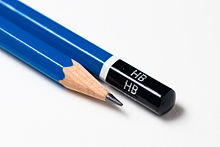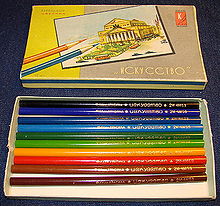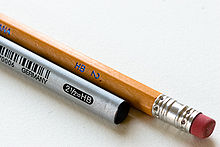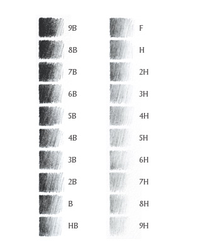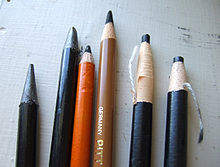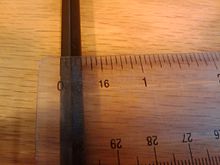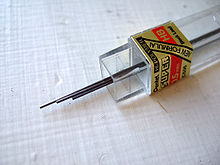- Pencil
-
A pencil is a writing implement or art medium usually constructed of a narrow, solid pigment core inside a protective casing. The case prevents the core from breaking, and also from marking the user’s hand during use.
Pencils create marks via physical abrasion, leaving behind a trail of solid core material that adheres to a sheet of paper or other surface. They are noticeably distinct from pens, which dispense liquid or gel ink that stain the light color of the paper.
Most pencil cores are made of graphite mixed with a clay binder, leaving grey or black marks that can be easily erased. Graphite pencils are used for both writing and drawing, and the result is durable: although writing can usually be removed with an eraser, it is resistant to moisture, most chemicals, ultraviolet radiation and natural ageing. Other types of pencil core are less widely used. Charcoal pencils are mainly used by artists for drawing and sketching. Colored pencils are sometimes used by teachers or editors to correct submitted texts but are more usually regarded as art supplies, especially those with waxy core binders that tend to smear on paper instead of erasing. Grease pencils have a softer crayon-like waxy core that can leave marks on smooth surfaces such as glass or porcelain.
The most common type of pencil casing is a thin wooden cylinder permanently bonded around the core. Similar permanent casings may be constructed of other materials such as plastic or paper. In order to use the pencil, the casing must be carved or peeled off to expose the working end of the core as a sharp point. Mechanical pencils have more elaborate casings that support mobile pieces of pigment core, which can be extended or retracted through the casing tip as needed.
Contents
History
The archetypal pencil may have been the stylus, which was a thin metal stick, often made from lead[dubious ] and used for scratching in papyrus[dubious ], a form of early paper. They were used extensively by the ancient Egyptians[dubious ] and Romans.[1] The word pencil comes from the Old French word pincel, a small paintbrush, ultimately deriving from the Latin word penicillus a "little tail" — pincellus is Latin from the post-classical period.[2]
Discovery of graphite deposit
Some time before 1565 (some sources say as early as 1500), an enormous deposit of graphite was discovered on the approach to Grey Knotts from the hamlet of Seathwaite in Borrowdale parish, Cumbria, England.[3][4][5] The locals found that it was very useful for marking sheep. This particular deposit of graphite was extremely pure and solid, and it could easily be sawn into sticks. This remains the only large scale deposit of graphite ever found in this solid form.[6] Chemistry was in its infancy and the substance was thought to be a form of lead. Consequently, it was called plumbago (Latin for "lead ore").[7][8] The black core of pencils is still referred to as lead, even though it never contained the element lead. The words for pencil in German (Bleistift), Irish (Peann Luaidhe), Arabic (قلم رصاص qalam ruṣāṣ), and other languages literally mean lead pen.
The value of graphite was soon realised to be enormous, mainly because it could be used to line the moulds for cannonballs, and the mines were taken over by the Crown and guarded. When sufficient stores of graphite had been accumulated, the mines were flooded to prevent theft until more was required. Graphite had to be smuggled out for use in pencils. Because graphite is soft, it requires some form of encasement. Graphite sticks were initially wrapped in string or sheepskin for stability. The news of the usefulness of these early pencils spread far and wide, attracting the attention of artists all over the known world.
Although deposits of graphite had been found in other parts of the world, they were not of the same purity and quality as the Borrowdale find, and had to be crushed to remove the impurities, leaving only graphite powder.[citation needed] England continued to enjoy a monopoly on the production of pencils until a method of reconstituting the graphite powder was found. The distinctively square English pencils continued to be made with sticks cut from natural duck graphite into the 1860s. The town of Keswick, near the original findings of block graphite still manufactures pencils, the factory also being the location of the Cumberland pencil museum.[9]
The first attempt to manufacture graphite sticks from powdered graphite was in Nuremberg, Germany, in 1662. It used a mixture of graphite, sulphur, and antimony.
Residual graphite from a pencil stick is not poisonous, and graphite is harmless if consumed.[10]
Wood holders added
An Italian couple named Simonio and Lyndiana Bernacotti[who?][when?] made what are likely the first blueprints for the modern, wood-encased carpentry pencil. Their version was a flat, oval, more compact type of pencil. Their concept involved the hollowing out of a stick of juniper wood. Shortly thereafter, a superior technique was discovered: two wooden halves were carved, a graphite stick inserted, and the halves then glued together—essentially the same method in use to this day.[11]
English and German pencils were not available to the French during the Napoleonic Wars; France, under naval blockade imposed by Great Britain, was unable to import the pure graphite sticks from the British Grey Knotts mines – the only known source in the world for solid graphite. France was also unable to import the inferior German graphite pencil substitute. It took the efforts of an officer in Napoleon's army to change this. In 1795, Nicholas Jacques Conté discovered a method of mixing powdered graphite with clay and forming the mixture into rods that were then fired in a kiln. By varying the ratio of graphite to clay, the hardness of the graphite rod could also be varied. This method of manufacture, which had been earlier discovered by the Austrian Joseph Hardtmuth of Koh-I-Noor in 1790, remains in use.[citation needed]
In England, pencils continued to be made from whole sawn graphite. Henry Bessemer's first successful invention (1838) was a method of compressing graphite powder into solid graphite thus allowing the waste from sawing to be reused.[12]
American colonists imported pencils from Europe until after the American Revolution. Benjamin Franklin advertised pencils for sale in his Pennsylvania Gazette in 1729, and George Washington used a three-inch pencil when he surveyed the Ohio Territory in 1762.[citation needed] It is said[by whom?] that William Munroe, a cabinetmaker in Concord, Massachusetts, made the first American wood pencils in 1812. This was not the only pencil-making occurring in Concord. According to Henry Petroski, transcendentalist philosopher Henry David Thoreau discovered how to make a good pencil out of inferior graphite using clay as the binder; this invention was prompted by his father's pencil factory in Concord, which employed graphite found in New Hampshire in 1821 by Charles Dunbar.
Munroe's method of making pencils was painstakingly slow, and in the neighbouring town of Acton, a pencil mill owner named Ebenezer Wood set out to automate the process at his own pencil mill located at Nashoba Brook along the old Davis Road. He used the first circular saw in pencil production. He constructed the first of the hexagon- and octagon-shaped wooden casings that we have today. Ebenezer did not patent his invention and shared his techniques with whomever asked. One of those was Eberhard Faber of New York, who became the leader in pencil production.[13]
Joseph Dixon, an inventor and entrepreneur involved with the Tantiusques granite mine in Sturbridge, Massachusetts, developed a means to mass produce pencils. By 1870, The Joseph Dixon Crucible Company was the world’s largest dealer and consumer of graphite and later became the contemporary Dixon Ticonderoga pencil and art supplies company.[14][15]
By the end of the 19th century over 240,000 pencils were used each day in the United States alone. The favoured timber for pencils was Red Cedar as it was aromatic and did not splinter when sharpened. In the early 20th century supplies of Red Cedar were dwindling so that pencil manufacturers were forced to recycle the wood from cedar fences and barns to maintain supply. Britain went as far as declaring the use of pencil sharpeners illegal to discourage unnecessary sharpening.[citation needed] It was soon discovered that Incense cedar, when dyed and perfumed to resemble Red Cedar, was a suitable alternative and most pencils today are made from this timber which is grown in managed forests. Over 14 billion pencils are manufactured worldwide annually.[16]
Eraser attached
On 30 March 1858, Hymen Lipman received the first patent for attaching an eraser to the end of a pencil.[17] In 1862 Lipman sold his patent to Joseph Reckendorfer for $100,000, who went to sue the pencil manufacturer Faber-Castell for infringement.[18] In 1875, the Supreme Court of the United States ruled against Reckendorfer declaring the patent invalid.[19]
Lead poisoning
Although lead has not been used for writing since roman times, lead poisoning from pencils was not uncommon; until the middle of the twentieth century the paint used for the outer coating could contain high concentrations of the element and this could be ingested when the pencil was sucked or chewed.[20]
Manufacture
Modern pencils are made industrially by mixing finely ground graphite and clay powders, adding water, forming long spaghetti-like strings, and firing them in a kiln. The resulting strings are dipped in oil or molten wax, which seeps into the tiny holes of the material, resulting in smoother writing. A juniper or incense-cedar plank with several long parallel grooves is cut to fashion a "slat," and the graphite/clay strings are inserted into the grooves. Another grooved plank is glued on top, and the whole assembly is then cut into individual pencils, which are then varnished or painted. Afterwards people can then add personal things like pencil grips and eraser toppers. Eraser toppers are extra erasers that can be removed after being used.
Grading and classification
"Pencil hardness" redirects here.Many pencils across the world, and almost all in Europe, are graded on the European system using a continuum from “H” (for hardness) to “B” (for blackness), as well as “F” (for fine point). The standard writing pencil is graded HB. According to Petroski, this system might have been developed in the early 20th century by Brookman, an English pencil maker. It used “B” for black and “H” for hard; a pencil's grade was described by a sequence or successive Hs or Bs such as BB and BBB for successively softer leads, and HH and HHH for successively harder ones.[21]
As of 2009, a set of pencils ranging from a very hard, light-marking pencil to a very soft, black-marking pencil usually ranges from hardest to softest as follows:
9H 8H 7H 6H 5H 4H 3H 2H H F HB B 2B 3B 4B 5B 6B 7B 8B 9B Hardest → Medium → Softest Koh-i-noor offers twenty grades from 10H to 8B for its 1500 series;[22] Derwent produces twenty grades from 9H to 9B for its graphic pencils[23] and Staedtler produces nineteen from 9H to 8B for its Mars Lumograph pencils.[24]
The main market for such wide range of grades are artists who are interested in creating a full range of tones from light grey to black. Engineers prefer harder pencils which allow for a greater control in the shape of the lead. This is reflected in the way pencils are packaged and marketed. For example, for its Graphic pencils Derwent offers three packages of 12 pencils each: Technical (with hard grades from 9H to B), Sketching (with soft grades H to 9B), and Designer (with medium grades 4H to 6B).[citation needed]
Pencils graded using this system are used to measure the hardness and resistance of varnishes and paints. The resistance of a coating (also known as its pencil hardness) is determined as the grade of the hardest pencil that does not mark the coating when pressed firmly against it at a 45 degree angle.[25][26]
Another common method uses numbers to designate the grade of a pencil. It was originally created by Conté and adopted in the United States by John Thoreau, father of Henry Thoreau, in the 19th century.[27] The following table shows approximate equivalences between the different systems:[28]
Tone U.S. World #1 B #2 HB #2½ * F #3 H #4 2H * Also seen as 2-4/8, 2.5, 2-5/10
Although Conté/Thoreau's system is widely accepted, not all manufacturers follow it; for example, Faber-Castell uses a different equivalence table in its Grip 2001 pencils: 1 = 2B, 2 = B, 2½ = HB, 3 = H, 4 = 2H.
The various graphite pencil grades are achieved by altering the proportion of graphite to clay: the more clay the harder the pencil.[29][30][31] Two pencils of the same grade but different manufacturers will not necessarily make a mark of identical tone nor have the same hardness.[32]
External color and shape of pencils
The majority of pencils made in the United States are painted yellow.[33] According to Henry Petroski,[34] this tradition began in 1890 when the L. & C. Hardtmuth Company of Austria-Hungary introduced their Koh-I-Noor brand, named after the famous diamond. It was intended to be the world's best and most expensive pencil, and at a time when most pencils were either painted in dark colours or not at all, the Koh-I-Noor was yellow. As well as simply being distinctive, the color may have been inspired by the Austro-Hungarian flag; it was also suggestive of the Orient at a time when the best-quality graphite came from Siberia. Other companies then copied the yellow color so that their pencils would be associated with this high-quality brand, and chose brand names with explicit Oriental references, such as Mikado (renamed Mirado)[35][36] and Mongol.[37][38]
Not all countries use yellow pencils, however; German and Brazilian pencils, for example, are often green, blue or black, based on the trademark colours of Faber-Castell, a major German stationery company which has major plants in those countries. In southern European countries pencils tend to be dark red or black with yellow lines while in Australia they are red with black bands at one end. In India the most common pencil colour scheme was dark red with black lines, and pencils with a large number of colour schemes are produced by various companies.
Pencils are commonly round, hexagonal or sometimes triangular in section. Carpenters' pencils (see below) are typically oval or rectangular, so they cannot easily roll away during work.
Notable pencil users
- Thomas Edison had his pencils specially made by Eagle Pencil. Each pencil was three inches long, was thicker than standard pencils and had softer graphite than was normally available.[39]
- Vladimir Nabokov rewrote everything he had ever published, usually several times, by pencil.[39]
- John Steinbeck was an obsessive pencil user and is said to have used as many as 60 a day. His novel East of Eden took more than 300 pencils to write.[39]
- Vincent van Gogh only used Faber pencils as they were "superior to Carpenters pencils, a capital black and most agreeable".[39][40]
- Johnny Carson regularly played with pencils at his Tonight Show desk. These pencils were specially made with erasers at both ends in order to avoid on set accidents.[41]
- Roald Dahl only used pencils with yellow casing to write his books. He had 6 sharpened pencils ready at the beginning of each day and only when all 6 pencils became unusable did he resharpen them.[citation needed]
Types
According to their marking material
- Graphite pencils
- These are the most common types of pencils, and are encased in wood. They are made of a mixture of clay and graphite and their darkness varies from light grey to black. Their composition allows for the smoothest strokes.
- Solid graphite pencils
- As the name implies, these are solid sticks of graphite, about the diameter of a common pencil, which have no casing. They are used primarily for art purposes as the lack of casing allows for more interesting effects. They are available in the same darkness range as wood-encased graphite pencils.
- Charcoal pencils
- They are made of charcoal and provide fuller blacks than graphite pencils, but tend to smudge easily and are more abrasive than graphite. Sepia-toned and white pencils are also available for duotone techniques.
- Carbon pencils
- They generally are made of a mixture of clay and lamp black, but are sometimes blended with charcoal or graphite depending on the darkness and manufacturer. They produce a fuller black than graphite pencils, but are smoother than charcoal.
- Coloured pencils, or pencil crayons
- These have wax-like cores with pigment and other fillers. Multiple colours are often blended together.[42]
- Grease pencils
- They write on virtually any surface (including glass, plastic, metal and photographs). The most commonly found grease pencils are encased in paper (Berol and Sanford Peel-off), but they can also be encased in wood (Staedtler Omnichrom).[42]
- Watercolour pencils
- These are designed for use with watercolour techniques. The pencils can be used by themselves for sharp, bold lines. Strokes made by the pencil can also be saturated with water and spread with brushes.[42]
According to their use
- Carpenter's pencils
- These are pencils that have two main properties: their shape prevents them from rolling, and their graphite is strong.[43] The oldest surviving pencil is a German carpenter's pencil dating from the 17th Century and now in the Faber-Castell collection.[44][45]
- Copying pencils
- These are graphite pencils with an added dye that creates an indelible mark. They were invented in the late 19th century for press copying and as a practical substitute for fountain pens. Their markings are often visually indistinguishable from those of standard graphite pencils, but when moistened their markings dissolve into a coloured ink, which is then pressed into another piece of paper. They posed significant health risks (see below).[46][47][48] They were widely used until the mid 20th century when ball pens slowly replaced them. In Italy their use is still mandated by law for voting paper ballots in elections and referenda. [49]
- Erasable colour pencils
- Unlike wax-based coloured pencils, these can be easily erased. Their main use is in sketching, where the objective is to create an outline using the same colour that other media (such as wax pencils, or watercolour paints) would fill[50] or when the objective is to scan the colour sketch.[51] Some animators prefer erasable colour pencils as opposed to graphite pencils because they don't smudge as easily, and the different colours allow for better separation of objects in the sketch.[52] Copy-editors find them useful too, as their markings stand out more than graphite but can be erased.[53]
- Non-reproducing
- or non-photo blue pencils make marks that are not reproduced by photocopiers[54] (Sanford's Copy-not or Staedtler's Mars Non-photo) or by whiteprint copiers (Staedtler's Mars Non-Print).
- Stenographer's pencil
- Also known as a steno pencil. These pencils are expected to be very reliable, and their lead is break proof. Nevertheless sometimes steno pencils are sharpened at both ends to enhance reliability. They are round to avoid pressure pain during long texts.[55]
- Golf pencil
- Golf pencils are usually short (a common length is 9 cm) and very cheap. They are also known as library pencils, as many libraries offer them as disposable, unspillable writing instruments.
According to their shape
- Triangular (more accurately a Reuleaux triangle)
- Hexagonal
- Round
- Bendable (flexible plastic)
According to their size
- Typical
- A standard, hexagonal, "#2 pencil" is cut to a hexagonal height of 1⁄4-inch (6 mm), but the outer diameter is slightly larger (about 9⁄32-inch (7 mm)).[56]
A standard, #2, hexagonal pencil is 19 cm (7.5 in) long.
- Biggest
- On 3 September 2007, Ashrita Furman unveiled his giant US$20,000 pencil – 76 feet (23 m) long, 18,000 pounds (8,200 kg) (with over 4,500 pounds (2,000 kg) for the graphite centre) – after three weeks of creation in August 2007 as a birthday gift for teacher Sri Chinmoy. It is longer than the 65-foot (20 m) pencil outside the Malaysia HQ of stationers Faber-Castell.[57][58][59]
According to their manufacture
There are also pencils which use mechanical methods to push lead through a hole at the end and are either propelling or clutch type. The erasers (sometimes replaced by a sharpener in larger lead sizes) are also removable (and thus replaceable), and usually cover a place to store replacement leads. Mechanical pencils are popular for their longevity and the fact that they may never need sharpening. Lead types are based on grade and size; with standard sizes being 2.00 mm, 1.40 mm, 1.00 mm, 0.70 mm, 0.50 mm, 0.35 mm, 0.25 mm, 0.18 mm, and 0.13 mm (ISO 9175-1)—the 0.9 mm size is available, but is not considered a standard ISO size.
- Pop a Point Pencils
Pioneered by Taiwanese stationery manufacturer Bensia Pioneer Industrial Corporation in the early 70's, the product is also known as Bensia Pencils, Plastic pencils
Invented by Arthur D. Little for Empire Pencil Company in the early 1970s; commercialised by Empire as the "EPCON" Pencil. These pencils were co-extruded, extruding a plasticised graphite mix within a wood-composite core.[61]
- Stackable pencils
Other types
- The Quadrachromic Pencil is a slightly enlarged pencil with four colours equally partitioned on the tip. The use of each color while drawing is accomplished by rotating the pencil between the fingers.
- Penny pencil
- Recycled newspaper pencil
Health risks
Indelible pencils were the cause of significant health risks due to the presence of aniline dyes. Exposure to aniline dyes could lead to eczema, acne and carcinoma. Penetration of the pencil lead into the body commonly leads to severe and debilitating effects such as fever, anaemia, elevated white cell count, gastro-intestinal upset, kidney and liver damage, anorexia and necrosis of the tissue surrounding the wound. Such risks are not associated with ordinary graphite pencils. While these symptoms may appear after a couple of days they often develop only after weeks have passed since the injury was sustained. Surgery is required to remove the lead and the infected tissue and "the necrotizing action may be so severe and extensive amputation is necessary". [62]
See also
- Venus Pencils
- Blackwing 602
Notes
- ^ Zumdahl, Steven S; Zumdahl, Susan A (2008). "No lead pencils". Chemistry. Belmont, CA: Cengage Learning. p. 343. ISBN 0-547-12532-1.
- ^ "pencil, n". Oxford English Dictionary (3 ed.). Oxford University Press. 2005.
- ^ Martin and Jean Norgate, Geography Department, Portsmouth University (2008). "Old Cumbria Gazetteer, black lead mine, Seathwaite". http://www.geog.port.ac.uk/webmap/thelakes/html/lgaz/lk00976.htm. Retrieved 2008-05-19.
- ^ Alfred Wainwright (2005). A Pictorial Guide to the Lakeland Fells, Western Fells. ISBN 0-7112-2460-9.
- ^ "Graphite from the Plumbago Mine, Borrowdale, England". Department of Physics at Michigan Technological University. http://www.phy.mtu.edu/~jaszczak/borrowdale.html. Retrieved 2008-03-27.
- ^ "Lakeland's Mining Heritage". www.cumbria-industries.org.uk. http://www.cumbria-industries.org.uk/wad.htm. Retrieved 2008-03-27.
- ^ "Definition of Plumbago". Answers.com. http://www.answers.com/topic/plumbago. Retrieved 2007-04-21.
- ^ "Definition of Plumbago". Thefreedictionary.com. http://www.thefreedictionary.com/plumbago. Retrieved 2007-04-21.
- ^ "Keswick Pencil Museum". Pencilmuseum.co.uk. http://www.pencilmuseum.co.uk/. Retrieved 2009-07-23.
- ^ "Graphite - Identification, toxicity, use, water pollution potential, ecological toxicity, and regulatory information". Pesticideinfo.org. http://www.pesticideinfo.org/Detail_Chemical.jsp?Rec_Id=PC33124. Retrieved 2009-07-23.
- ^ Historyofscience.com
- ^ Bessemer, Henry. "Sir Henry Bessemer, F.R.S: An Autobiography. Chapter 3."
- ^ "Acton Conservation Lands, Early American Pencils". Actontrails.org. http://www.actontrails.org/EAPencils.htm. Retrieved 2009-07-23.
- ^ "Dixon Ticonderoga Company". Dixonusa.com. http://www.dixonusa.com/index.cfm/fuseaction=history.dixon. Retrieved 2009-07-23.
- ^ "Tantiusques Graphite Mine". Thetrustees.org. http://www.thetrustees.org/pages/368_tantiusques.cfm. Retrieved 2009-07-23.
- ^ "The Point Of It All". Discovery Channel Magazine. Volume 1, Issue 5, 2008
- ^ "US Patent 19783 Combination of Lead-Pencil and Eraser by L. Lipman". Patft.uspto.gov. http://patft.uspto.gov/netacgi/nph-Parser?patentnumber=19783. Retrieved 2009-07-23.
- ^ Petroski, Henry (1990). The Pencil: A History of Design and Circumstance. New York: Alfred A. Knopf. pp. 171. ISBN 0-394-57422-2.
- ^ "Reckendorfer v. Faber 92 U.S. 347 (1875)". Supreme.justia.com. http://supreme.justia.com/us/92/347/case.html. Retrieved 2009-07-23.
- ^ "Pencils, paint and pottery can give you lead poisoning". Life 73 (1): 46. 7 July 1972.
- ^ Petroski, 1990, p. 157
- ^ Koh-i-noor Catalog: Graphite Pencis, koh-i-noor.cz[dead link]
- ^ "Derwent Graphic". Pencils.co.uk. http://www.pencils.co.uk/products/derwent.aspx?sid=3&p=1. Retrieved 2009-07-23.[dead link]
- ^ Staedtler.com, Staedtler Mars Lumograph Pencils. Retrieved 21 August 2007.
- ^ This testing method is approved by the ISO as standard ISO 15184:1998 Paints and varnishes -- Determination of film hardness by pencil test ISO.org. See pra-world.com for a description of the test. Unfortunately the hardness of pencils is not standardised. For this reason the standard specifies various brands of pencils that are to be used in this test.
- ^ Simmons, Mac (April 2000). "The Pencil Hardness Test". Woodwork: 76. http://www.pencilpages.com/articles/simmons.htm. Retrieved 13 September 2007.
- ^ Petroski claims that Conté used integer numbers that started at 1, with higher numbers indicating softer leads, while Thoreau used higher numbers to designate harder leads (Petroski, 1990, page 157). It is believed that Thoreau developed independently his method of mixing clay and graphite, and his use of numbers to designate grades is evidence that he was at least aware of Conté methods and tried to reverse engineer them. Thoreau offered pencils graduated from 1 to 4 in the middle 1800s (Petroski, 1990, p. 119), see also "Thoreau's Pencils". John H. Lienhard. The Engines of Our Ingenuity. NPR. KUHF-FM Houston. 1989. No. 339. Transcript. uh.edu
- ^ Petroski, 1990, p. 230
- ^ "Staedtler Pencil, video". http://www.staedtler.com/upload/graphite_video_eng_16461.mpg. Retrieved 2009-07-23. Staedtler.com
- ^ Petroski, 1990
- ^ "Derwent Manufacturing Process". Pencils.co.uk. http://www.pencils.co.uk/heritage.aspx?id=6&sid=1. Retrieved 2009-07-23.
- ^ Petroski claims that pencil grades vary "depending upon the manufacturer, when the pencils are made, and the source of graphite and clay. One analyst found that graphitic carbon content, for example, to vary from about 30 to about 65 in a variety of different pencils bearing the same designation." Petroski, 1990, page 229
- ^ 75% of the 2.8 billion pencils made in the United States are painted yellow (Steve Ritter "Pencils & Pencil Lead", Chemical & Engineering News, Volume 79, Number 42 page 35, 15 October 2001). Pubs.acs.org
- ^ Petroski, 1990, pp. 162-163
- ^ Eagle Pencil Company applied for the trademark Mirado in 1947 (US Trademark 71515261). It is common belief that this was an attempt to disassociate the pencil brand from Japan, as one of the meanings of Mikado is emperor of Japan. Petroski (Petroski, 1990) states that Eagle Pencil Company changed the name after the Attack on Pearl Harbor.
- ^ Mikado/Mirado pencils were originally made by Eagle Pencil Company--today Berol--but can also be found today under the trademark Papermate and Sanford as Sanford owns Berol and the trademark Papermate Brandnamepencils.com Mirado Pencil
- ^ "Eberhard Faber Pencil Gallery". Pencilpages.com. http://www.pencilpages.com/gallery/eberhard-faber/mongol.htm. Retrieved 2009-07-23.
- ^ Originally made by Eberhard Faber the Mongol trademark is now owned by Sanford Timberlines.blogspot.com Timberlines Blog "Mongolized" 31 August 2005. Retrieved 23 August 2007.
- ^ a b c d "Famous Pencil Pushers". Readers Digest. http://www.readersdigest.com.au/content/printContent.do?contentId=109024.
- ^ Faber-castell.co.nz, Faber Castell's friends
- ^ http://www.imdb.com/title/tt0055708/trivia?tr0701188
- ^ a b c Categories of Wax-Based Drawing Media, palimpsest.stanford.edu
- ^ Doug Martin (2000). "Carpenter's Pencils". Pencilpages.com. http://www.pencilpages.com/articles/carpentr.htm. Retrieved 2009-07-23.
- ^ "History Pencils & Historic Packaging" Faber Castell Australia[dead link]
- ^ "Oldest Known Pencil in Existence". Pencilpages.com. http://www.pencilpages.com/gallery/oldest.htm. Retrieved 2009-07-23.
- ^ Liz Dube. "The Copying Pencil: Composition, History, and Conservation Implications". Aic.stanford.edu. http://aic.stanford.edu/sg/bpg/annual/v17/bp17-05.html. Retrieved 2009-07-23.
- ^ "The Magic of Purple Pencil". Blog.awm.gov.au. 2007-04-17. http://blog.awm.gov.au/lambert/?p=95. Retrieved 2009-07-23.
- ^ "L. & C. Hardmuth Koh-I-Noor Kopierstift 1561". Penciltalk.org. http://www.penciltalk.org/2006/03/l-c-hardmuth-koh-i-noor-kopierstift-1561. Retrieved 2009-07-23.
- ^ "L. 6 febbraio 1948 , n. 29". http://www.senato.it/istituzione/108452/152259/genpagspalla.htm. Retrieved 2011-08-01.
- ^ "Art Supplies". Mccannas.com. http://www.mccannas.com/sketch/supply.htm. Retrieved 2009-07-23.
- ^ "Sketch to Paint in Photoshop". Digitalartsonline.co.uk. http://www.digitalartsonline.co.uk/tutorials/index.cfm?FeatureID=1625. Retrieved 2009-07-23.
- ^ "Tools of the Trade Papers Pencils and Erases". smackjeeves.com. http://smacktalk.smackjeeves.com/03-paperpencilserasers/. Retrieved 2009-07-23.
- ^ "See comment "As a professional copy-editor..."". Pencilrevolution.com. http://www.pencilrevolution.com/2005/10/writing-in-color/. Retrieved 2009-07-23.
- ^ "Sanford Col-Erase Copy Not Pencils-You Can't Copy This Baby!". Epinions.com. http://www.epinions.com/content_285308063364. Retrieved 2009-07-23.
- ^ "Paper and Pencil Blog "Reporter Pencils"". Penciltalk.org. http://www.penciltalk.org/2006/06/reporter-pencils. Retrieved 2009-07-23.
- ^ File:PencilMeasurement.jpg
- ^ World's largest pencil. The Pencil Pages.
- ^ World’s largest pencil unveiled in New York. Sri Chinmoy News.
- ^ World's largest pencil (video). Metacafe.com.
- ^ http://www.bensia.com.tw/index.htm
- ^ For information about this invention see the writeup on ADL Chronicles The Epcon Plastic Pencil, adlittlechronicles.blogspot.com.
- ^ Indelible Pencil Injuries to the Hands ; Michael L Mason, MD and Harvey S Allen, MD ; Annals of Surgery, 1941, January, vol 113 no. 1, pages 131 - 139
References
- Petroski, Henry (1990). The Pencil: A History of Design and Circumstance. New York: Alfred A. Knopf. ISBN 0-394-57422-2.
- Petroski, Henry. H. D. Thoreau, Engineer.. 5. 8–16.
External links
- The history of pencils, pencils.com
- Pencil made, pencils.net
- Video produced by Staedtler showing how pencils are made (55.3 MB), staedtler.com
- Recycling newspapers into pencils, treesmart.com

